口译笔记速记符号归总
听写速记 口译笔记速记符号归总
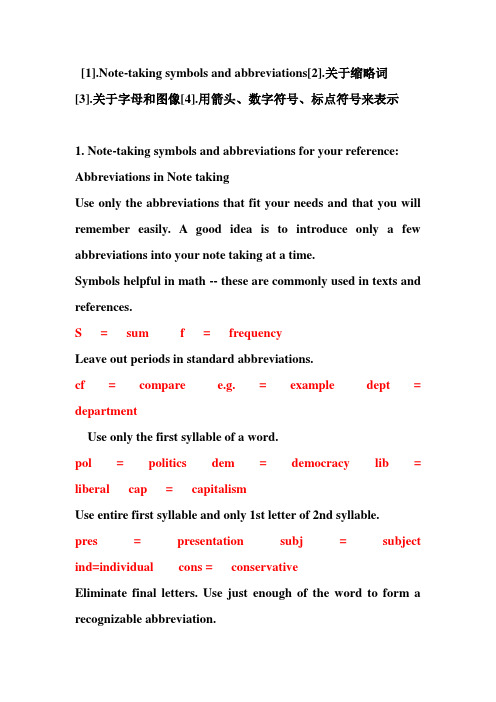
[1].Note-taking symbols and abbreviations[2].关于缩略词[3].关于字母和图像[4].用箭头、数字符号、标点符号来表示1. Note-taking symbols and abbreviations for your reference: Abbreviations in Note takingUse only the abbreviations that fit your needs and that you will remember easily. A good idea is to introduce only a few abbreviations into your note taking at a time.Symbols helpful in math -- these are commonly used in texts and references.S = sum f = frequencyLeave out periods in standard abbreviations.cf = compare e.g. = example dept = departmentUse only the first syllable of a word.pol = politics dem = democracy lib = liberal cap = capitalismUse entire first syllable and only 1st letter of 2nd syllable.pres = presentation subj = subject ind=individual cons = conservativeEliminate final letters. Use just enough of the word to form a recognizable abbreviation.assoc = associate biol =biology info=information ach=achievementchem= chemistry max=maximum intro=introduction conc=concentration min=minimum rep = repetitionOmit vowels, retain only enough consonants to give a recognizable skeleton of the word.ppd = prepared prblm = problem estmt = estimatebkgd = background gvt = governmentUse an apostrophe in place of letters.am't = amount cont'd = continuedgov't = government educat'l = educationalForm the plural of a symbol or abbreviated word by adding s. chpts = chapters egs = examplesfs = frequencies intros = introductionsUse g to represent ing endings.ckg = checking estg = establishingdecrg = decreasing exptg = experimentingIf a term, phrase, or name is written out in full during the lecture, substitute initials whenever the term, phrase, or name isused again. For example, Center for Aerospace Sciences becomes CAS thereafter.Use symbols for commonly recurring connective or transitional words.& = and w/ = withw/o = without vs = against\ = therefore = = is or equalUse technical symbols where applicable.zb = German, for example ibid = Latin, the same worko = degrees H2O = waterMore reference:Use standard maths, accounting, and science symbols. Examples:+ plus // parallelUse standard abbreviations and leave out full stops. Examples: eg exampleIT dept Information Technology departmentUK United KingdomUse only the first syllable of a word. Examples:mar marketing cus customer cli clientUse the entire first syllable and the first letter of the secondsyllable. Examples:subj subject budg budget ind individualTo distinguish among various forms of the same word, use the first syllable of the word, an apostrophe, and the ending of the word. Examples:tech'gy technology gen'ion generalisation del'y delivery Use just enough of the beginning of a word to form a recognisable abbreviation. Examples:assoc associated ach achievement info informationOmit vowels from the middle of words, retaining only enough consonants to provide a recognisable skeleton of the word. Examples: 省略原音字母bkgd background mvmt movement prblm problemForm the plural of a symbol or abbreviated word by adding 's.' Examples:custs customers fs frequencies /s ratiosUse 'g' to represent 'ing' endings. Examples:decrg decreasing ckg checking estblg establishingSpell out, rather than abbreviate short words. Examples:in but as key省去非重要的单词Leave out unimportant verbs. Examples:is was were省去不必要的单词Leave out unnecessary articles. Examples:a an theIf a term, phrase, or name is initially written out in full during the talk or meeting, initials can be substituted whenever the term, phrase, or name is used again. Example:January Advertising Campaign Budget JACBUse symbols for common connective or transition words. Examples:@ at 2 to 4 for & and w/ with w/o without vs againstCreate your own set of abbreviations and symbols. You may wish to develop separate sets of symbols and abbreviations for different courses or subjects.Other Symbols and Abbreviationsas a result of / consequences of <---> resulting in ---> and / also + equal to / same as = following ff most importantly * less than < greater than > especially esp/ 一、缩略词英语当中缩略词使用的频率很高,如IMP: important, ASAP: as soon as possible。
口译笔记速记符号归总

口译笔记速记符号归总(一)1. Note-taking symbols and abbreviations for your reference:Abbreviations in Note takingUse only the abbreviations that fit your needs and that you will remember easily. A good idea is to introduce only a few abbreviations into your note taking at a time.Symbols helpful in math —— these are commonly used in texts and references.S = sumf = frequencyLeave out periods in standard abbreviations.cf = comparee.g. = exampledept = departmentUse only the first syllable of a word.pol = politicsdem = democracylib = liberalcap = capitalismUse entire first syllable and only 1st letter of 2nd syllable.pres = presentationsubj = subjectind = individualcons = conservativeEliminate final letters. Use just enough of the word to form a recognizable abbreviation.assoc = associatebiol = biologyinfo = informationach = achievementchem = chemistrymax = maximumintro = introductionconc = concentrationmin = minimumrep = repetitionOmit vowels, retain only enough consonants to give a recognizable skeleton of the word.ppd = preparedprblm = problemestmt = estimatebkgd = backgroundgvt = governmentUse an apostrophe in place of letters.am't = amountcont'd = continuedgov't = governmenteducat'l = educationalForm the plural of a symbol or abbreviated word by adding s.chpts = chaptersegs = examplesfs = frequenciesintros = introductionsUse g to represent ing endings.ckg = checkingestg = establishingdecrg = decreasingexptg = experimentingSpell out short words such as in, at, to, but, for, and key.Abbreviations or symbols for short words will make the notes too dense with shorthand.Leave out unimportant words.Leave out the words a and the.If a term, phrase, or name is written out in full during the lecture, substitute initials whenever the term, phrase, or name is used again. For example, Center for Aerospace Sciences becomes CAS thereafter.Use symbols for commonly recurring connective or transitional words.& = andw/ = withw/o = withoutvs = against\ = therefore= = is or equalUse technical symbols where applicable.zb = German, for exampleibid = Latin, the same worko = degreesH2O = waterMore reference:Use standard maths, accounting, and science symbols. Examples:+ plus// parallelUse standard abbreviations and leave out full stops. Examples:eg exampleIT dept Information Technology departmentUK United KingdomUse only the first syllable of a word. Examples:mar marketingcus customercli clientUse the entire first syllable and the first letter of the second syllable. Examples:subj subjectbudg budgetind individualTo distinguish among various forms of the same word, use the first syllable of the word, an apostrophe, and the ending of the word. Examples:tech'gy technologygen'ion generalisationdel'y deliveryUse just enough of the beginning of a word to form a recognisable abbreviation. Examples: assoc associatedach achievementinfo informationOmit vowels from the middle of words, retaining only enough consonants to provide a recognisable skeleton of the word. Examples:bkgd backgroundmvmt movementprblm problemForm the plural of a symbol or abbreviated word by adding 's.' Examples:custs customersfs frequencies/s ratiosUse 'g' to represent 'ing' endings. Examples:decrg decreasingckg checkingestblg establishingSpell out, rather than abbreviate short words. Examples:inbutaskeyLeave out unimportant verbs. Examples:iswaswereLeave out unnecessary articles. Examples:aantheIf a term, phrase, or name is initially written out in full during the talk or meeting, initials can be substituted whenever the term, phrase, or name is used again. Example:January Advertising Campaign Budget JACBUse symbols for common connective or transition words. Examples:@ at2 to4 for& andw/ withw/o withoutvs againstCreate your own set of abbreviations and symbols. You may wish to develop separate sets of symbols and abbreviations for different courses or subjects.Other Symbols and Abbreviationsas a result of / consequences of <——>resulting in ——>and / also +equal to / same as =following ffmost importantly *less than <greater than > especially esp口译笔记速记符号归总(二)一、缩略词英语当中缩略词使用的频率很高,如IMP: important, ASAP: as soon as possible.很显然如果能熟练掌握缩略词,会对考试大有裨益。
口译笔记速记符号归总2
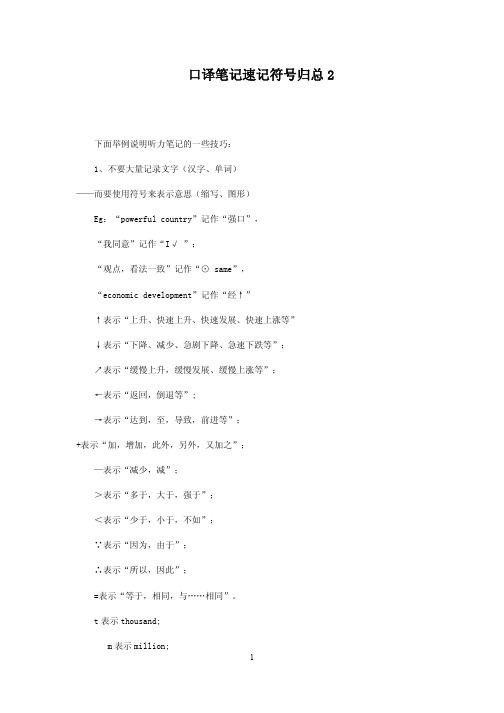
口译笔记速记符号归总2下面举例说明听力笔记的一些技巧:1、不要大量记录文字(汉字、单词)——而要使用符号来表示意思(缩写、图形)Eg:“powerful country”记作“强口”,“我同意”记作“I√ ”;“观点,看法一致”记作“⊙ same”,“economic development”记作“经↑”↑表示“上升、快速上升、快速发展、快速上涨等”↓表示“下降、减少、急剧下降、急速下跌等”;↗表示“缓慢上升,缓慢发展、缓慢上涨等”;←表示“返回,倒退等”;→表示“达到,至,导致,前进等”;+表示“加,增加,此外,另外,又加之”;—表示“减少,减”;>表示“多于,大于,强于”;<表示“少于,小于,不如”;∵表示“因为,由于”;∴表示“所以,因此”;=表示“等于,相同,与……相同”。
t表示thousand;m表示million;b表示 billion;1st表示first。
2、不要横着写:——而要竖着写,竖起来记有利于保持活意思意思以及数量等信息之间的逻辑界限。
3、逻辑关系要清楚明了——不要记流水帐。
以上是一些通行的的原则。
通行的原则存在,通行的方式却不存在,这是因为每个人的对记录符号的使用可能是多样的,同一事物不同的人可能会使用不同的符号,同一符号在不同的人意识中肯能代表不同的意思。
口译速记技巧口译考试之所以难,在于其长度和规定的限时。
估计很多参加过第二阶段口译考试的考生都有这样的经历,听的时候大意可以听懂,但是由于听时未作任何速记,关键词汇,逻辑关系在听后无法正确归纳,导致最后只能译出第一句或最后一句,而中间部分则完全忽略或遗忘。
真是如此,你是不可能通过口译考试的。
因此,自己在平日练习时一定要把速记归入计划之内。
总体上来说,速记符号主要有以下几类 :A。
保留大写字母或第一音节经济: E 教育: Edu 文化: C 政治: P 科技: ST 卫生: H旅游: T 环境: En 工业: I 农业: AB.简写缩略AFAC : as far as … is concerned( 就 …… 而言 )LFT : look forward to ( 期待 )ASAP : as soon as possible( 尽快 )C.图象⊕ 高兴,同意,满意等,如: happy , pleased , satisfied , agree…◎ 悲伤,生气,不满,不同意等,如:sad , angry , irritated , unsatisfied , sorrowful , discomfort , disagree… ⊙ 会议,如 conference , meeting , seminar , symposium…□ 国家,地区,如:中国:□ C ,俄国:□ RD.符号﹢高兴,男性,同意,增加等,如happy , male , agree , many , +2=more , +3=most , beneficial , good , beautiful , great , gorgeous…-悲伤,女性,不同意,减少等,如sad , female , disagree , little , few , -2=less , -3=least , lack of ,short of…√同意,正确等,如: agree , correct , right…×不同意,错误等,如: disagree , incorrect…↑增长,进步等,如: increase , soar , mushroom , rocket , make progress… ↓下降,退步,恶化等,如 decrease , sink , slide , subside , plump , plunge ,drop , degrade ,deteriorate…>多于,超过,比 …… 低一级等,如: more than , greater than , begger than ,better than , superior to , surpass , transcend , overtake…<少于,比 …… 低级等,如: less than , lower than , smaller than , inferior to…~大约,如: approximately , about , around , some , nearly , almost , similar to…/否定,清除,如: clear , settle , solve , tackle , conquer , eliminate ,extinct…≠与 …… 不同,如: differ from , different from , distinct , unique…$ 金钱,利益,如: interest , benefit , money , fund , capital…E.标点? 问题,麻烦,障碍,如: question , issue , difficult , hardship , barrier ,obstacle…: 主观想法和说辞,如: think , consider , speak , say , talk , mark , announce ,declare , hope ,例: repeat 或 reaffirm 可以用 :2 来替代,声明支持可以用 + :来替代,谴责用 - :。
口译笔译速记符号归总

口译笔译辅导:备考资料之口译速记符号归总字母、图像Z 表示"人"people/person,因为"Z"看上去像个人头,它通常被写在一个词或符号的右上角。
例如:日本人:JZ。
C 表示政府,统治:government,govern 希腊字母C读/ga:ma/,近似government, 所以就用C来表示govern, government。
governmental official 可以表示为 CZP 表示政治:politics, political希腊字母P读/pai/,近似politics, political。
那么politician 就可以表示为 PZE 表示总数:total, totally, entire, entirely, on the whole, all in all, to sum up, ect.E 数学符号表示总值。
G 表示效率:efficient, effective。
G为效率符号。
Q 表示"通货膨胀":inflation因为这个符号酷似一个上升的气球。
A 表示农业: agriculture. agriculture经常用到,所以用首字母代替。
B 表示商业:business。
C×表示冲突,矛盾:conflict, confrontation "C×"中的"×"表示反对,字母"C"将反对的概念缩小为conflict 和 confrontation。
W 表示工作,职业: work, employ 等。
它是work的第一个字母。
所以WZ就可以用来表示worker, 而W(Z在字母上方表示employer, 在字母下方表示employee)。
i 表示工业: industry, industrial 字母i 像只烟囱,所以用来可以用来表示工业。
口译中笔记法重点符号汇总
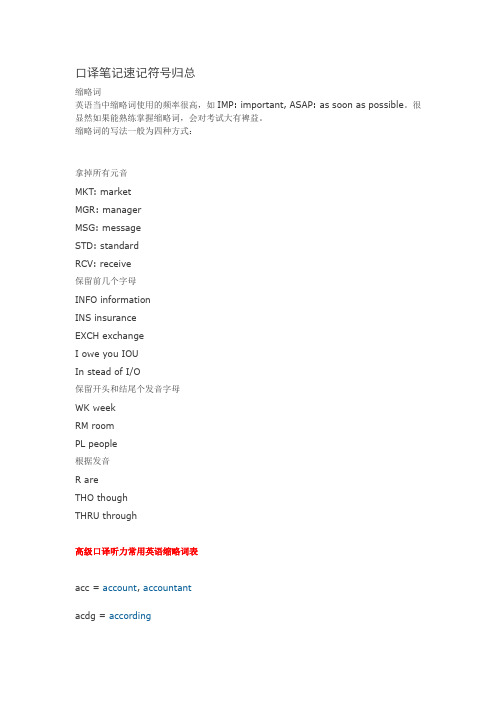
口译笔记速记符号归总缩略词英语当中缩略词使用的频率很高,如IMP: important, ASAP: as soon as possible。
很显然如果能熟练掌握缩略词,会对考试大有裨益。
缩略词的写法一般为四种方式:拿掉所有元音MKT: marketMGR: managerMSG: messageSTD: standardRCV: receive保留前几个字母INFO informationINS insuranceEXCH exchangeI owe you IOUIn stead of I/O保留开头和结尾个发音字母WK weekRM roomPL people根据发音R areTHO thoughTHRU through高级口译听力常用英语缩略词表acc = account, accountantacdg = accordingacpt = acceptad = advertisementadm = administrationads = addressadv = adviceagr = agricultureagt = agentalt = altitudea.m. = ante meridiem = before noon AMAP = as much as possibleamb = ambassadoramt = amountanal = analysisanc = ancientanon = anonymousans = answerapp = appendixApr = Aprilapt = apartmentarch = architecturearr = arrive; arrivalASAP = as soon as possibleass = assistant; associationat = atmosphere; atomicatt = attorney; attentionAug = Augustaux = auxiliaryav = averageave = avenuea.w.l. = absent with leave (准假)a.w.o.l. = absent without official leave (无故缺席) B.A. = Bachelor of Artsbal = balanceB.C. = before Christbd = boardbdl = bundlebk = bank; bookbkts = basketsB/L = bill of lading (提单)BLDG = buildingbp = birthplacebr = branch; brotherB.S. = Bachelor of Sciencebu = bureauC = capacity; century; chapter; centigrade; cost; city; center cal = calendar; caliber; caloriescap = capital; captaincat = catalogcc = carbon copy (复印件;抄送)CEO = chief executive officercert = certificateCFM = confirmcncl = cancelcp. = comparecit = citizenciv = civil; civilizationclk = clerkcml = commercialco. = companyc/o = care of(转交)col = college; colorcom = commentary; common; communication; community comm = commissioncomp = complete; computer; competition con = conclusion; againstcond = conditioncont. = continent; continuedcorp = corporationcust = customer; custom; customsDec = Decemberdec = deceased; declarationdef = defender; defensedeg = degreedep = depositDEPT = departmentdisc = discountdist = distance; distinguishdiv = divide; divorceddo. = ditto (同上)dorm = dormitorydpt = departuredz = dozene = east; earth; engineeringecon = economics; economyed. = education; editore.g. = exempli gratia = for example encl. = enclosed; enclosureesp. = especiallyetc. = et cetera = and so onex. = example; exception; extraexp. = exportexpln = explainext = extend; extensionFAX = facsimileFeb. = Februaryfem = female; feminineff. = followingfig = figuresfin = finance; financialfl = fluidFLT = flightFOB = free on board (船上交货;离岸价格) for = foreign; forestryfp = freezing pointfr = frequentFri. = Fridayfrt = freight (货物;货运)ft = foot; feet (脚;英寸)fut = futureFYR = for your reference (仅供参考)g = gold; grain; guide; gender; gravity G.A. = General Assembly (联合国大会) gen. = generallygent = gentleman; gentlemengm = gram; general managergov = governmentgs = general secretary (秘书长)h = harbor; hundred; husband; hydrogen hd = head (头部;首脑)hf = halfHon = honorable; honoraryH.Q. = headquartershr = hourht = heighthypoth = hypothesis; hypotheticali.a. = in absence; absentib. = ibidem = in the same placeID = identity; identity cardi.e. = id est = that isimp = import; imperialIMPS = impossibleIMPT = importantin. = inch; inchesind = industrial; independentindiv = individualinfo = informationins = insuranceinst. = instant; instituteint. = interior; interest (兴趣;利息)I/O = instead ofIOU = I owe you (借据)I.Q. = intelligence quotientIVO = in view of (鉴于,考虑到)is. = islandJ = judge; justicejour = journal; journalistjr. = junior (大学三年级学生; 年少的; 初级的)kg = kilogram (千克;公斤)km = kilometer (公里)lat. = latitudelb. = pounds (磅;英镑)L/C = letter of credit (信用证)leg = legallib = library; librarianliq = liquidlit = literaturelong. = longitudeM.A. = Master of Artsmach = machinerymag = magazineman. = manual; manufactureMar = Marchmath = mathematicsMDL = model (型号;模特)Mdm = Madammed. = medicine; medicalmem = member; memoir (回忆录) memo = memorandum (备忘录)mid = middlemin = minute; minimummkt. = marketmod = moderate; modernMon. = Mondaymph = mile per hour (每小时英里数; 车速) Mr. = MisterMrs. = MistressMS = manuscripts (手稿)msg = messageMt = Mount; mountainmus = music; museumn = north; noon; name; normalnat = national; native; naturaln.d. = no date (无日期)NLT = not later than (不迟于)No. = numberNov. = Novembernr = nearobj = object; objectiveobs = obsolete (过时的); observeobt = obtainOct. = Octoberoff. = office; officialop. = opera; operation; oppositeord = ordinaryorg = organizationorig = originaloz. = ounce (盎司)p. = page; power; pressurepara = paragraphpart = particular; partnerpass = passive; passengerPAT = patentpayt = paymentpc = piece; personal computerpd. = paid (钱款)已付perf = perform; performancePh.D. = Doctor of Philosophypk = park; peak (备注:pk这个符号大家可以根据时髦的用语来灵活拓展其含义) pkg = packagePLS = pleasep.m. = post meridiem = [w]afternoon POB = post-office boxpop = popular; populationpr. = pair; preferredprec = precedingprim = primary; primitiveprin. = principlepro = productProf. = professorpub. = public; publishqr. = quarterqt. = quantityqua = qualityr. = radius; railroad; retiredrcd = receivedrcpt = receiptRd = roadre = about (关于)reg = register; regionrep = representativerev = revise; reverse; revenuerm. = roomrpt = report; repeatSat. = Saturdaysch = schoolsci = sciencesec = second; section; sectorsig. = signal; signaturesitn = situationsp. = species (物种); specimen (标本) sq. = squareSTD = standardSun. = Sundaysurg = surgery; surgeontech = technologytel. = telephonetemp = temporary; temperature Thur. = ThursdayTKS = thankstrans = transaction; translationtrf = trafficTu. = TuesdayT.U. = Trade Union (英)工会ult = ultimateUN = United Nationsuniv = universityup = upperusu. = usuallyvil = villageV.P. = Vice Presidentvs. = versusv.v. = vice versa (反之亦然)wel = welcome; welfareXL = extra large (特大号)二、字母、图像Z 表示"人"people/person,因为"Z"看上去像个人头,它通常被写在一个词或符号的右上角。
口译常用的笔记符号汇总

众说纷纭,若干说法 various opinions
∞
1. 交流,交换 2. exchange, interact, communicate
2. 关系 interaction, relation, relationship partnership
双边关系,bilateral relationship
多边关系,multilateral relationshipBiblioteka 峰会 summit (meeting)
1. 关联 2. link to, connect with, relate to, 3. associate with
2. 替代 replace, displace, supplant, substitute instead of, take the place of
举杯,协议 toast, agreement, treaty, contract Convention, revolution 双边协议,bilateral agreement 多边协议,multilateral agreement
⊕
发展,develop, development 发达的,developed 发展中的,developing
village, farm, outskirt, countryside, suburban, rural areas
右上角:人 右下角:地方、地名、机构
领导,监督; 顶点,顶级,最 lead, supervise, head, peak, top, supreme, utmost, maximum, climax
记忆,属于一种储存性的永久记忆。影响 一个人短时记忆的因素很多,其中最主要 的因素是记忆内容的意义性。即便是当感 知的信息有意义时,人的短时记忆只可容 纳由二十多个单词组成的句子,或者一组 十位数的数字。因此,对于口译工作者来 说,完全依赖人脑的记忆能力是危险的,
口译笔记速记符号归总---笔记符号汇总哈1

Spell out short words such as in, at, to, but, for, and key.
ind = individu al cons = conserva tive
Eliminat e final letters. Use just enough of the word to form a recogniz able abbrevia tion. assoc = associat e biol = biology info = informat ion ach = achievem ent chem = chemistr y max = maximum intro = introduc tion conc = concentr ation min = minimum rep = repetiti on
Use only the first syllable of a word. pol = politics dem = democrac y lib = liberal cap = capitali sm
Use entire first syllable and only 1st letter of 2nd syllable . pres = presenta tion subj = subject
高级口译 听力常用 英语缩略 词表
缩略词 原词 APT Apartmen t ACC Accounta nt ACDG Accordin g
口译笔记速记符号归总
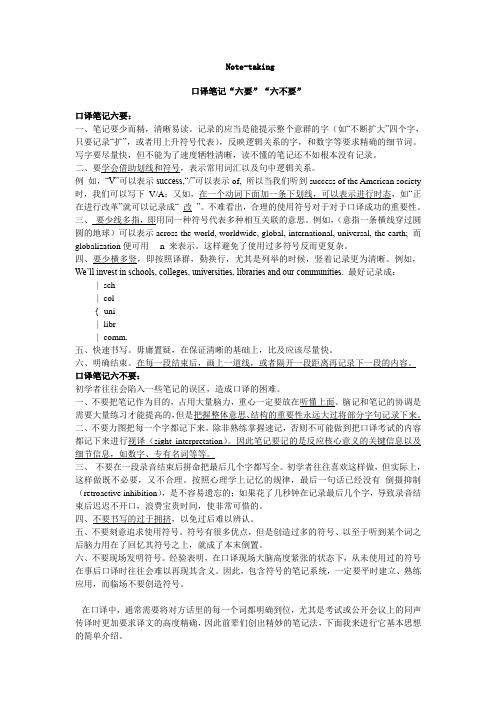
Note-taking口译笔记“六要”“六不要”口译笔记六要:一、笔记要少而精,清晰易读。
记录的应当是能提示整个意群的字(如“不断扩大”四个字,只要记录“扩”,或者用上升符号代表),反映逻辑关系的字,和数字等要求精确的细节词。
写字要尽量快,但不能为了速度牺牲清晰,读不懂的笔记还不如根本没有记录。
二、要学会借助划线和符号,表示常用词汇以及句中逻辑关系。
例如,“V”可以表示success,“/”可以表示of, 所以当我们听到success of the American society 时,我们可以写下V/A;又如,在一个动词下面加一条下划线,可以表示进行时态,如“正在进行改革”就可以记录成“ 改”。
不难看出,合理的使用符号对于对于口译成功的重要性。
三、要少线多指,即用同一种符号代表多种相互关联的意思。
例如,(意指一条横线穿过圆圆的地球)可以表示across the world, worldwide, global, international, universal, the earth; 而globalization便可用n 来表示。
这样避免了使用过多符号反而更复杂。
四、要少横多竖,即按照译群,勤换行,尤其是列举的时候,竖着记录更为清晰。
例如,We’ll invest in schools, colleges, universities, libraries and our communities. 最好记录成:|- sch|- col{- uni|- libr|- comm.五、快速书写。
毋庸置疑,在保证清晰的基础上,比及应该尽量快。
六、明确结束。
在每一段结束后,画上一道线,或者隔开一段距离再记录下一段的内容。
口译笔记六不要:初学者往往会陷入一些笔记的误区,造成口译的困难。
一、不要把笔记作为目的,占用大量脑力,重心一定要放在听懂上面。
脑记和笔记的协调是需要大量练习才能提高的,但是把握整体意思、结构的重要性永远大过将部分字句记录下来。
英翻汉 口译符号归总

口译笔记速记符号归总Note-taking symbols and abbreviations1. Note-taking symbols and abbreviations for your reference:Abbreviations in Note takingUse only the abbreviations that fit your needs and that you will remember easily.A good idea is to introduce only a few abbreviations into your note taking at a time.Symbols helpful in math -- these are commonly used in texts and references. S = sumf = frequencyLeave out periods in standard abbreviations.cf = comparee.g. = exampledept = departmentUse only the first syllable of a word.pol = politicsdem = democracylib = liberalcap = capitalismUse entire first syllable and only 1st letter of 2nd syllable.pres = presentationsubj = subjectind = individualcons = conservativeEliminate final letters. Use just enough of the word to form a recognizable abbreviation.assoc = associatebiol = biologyinfo = informationach = achievementchem = chemistrymax = maximumintro = introductionconc = concentrationmin = minimumrep = repetitionOmit vowels, retain only enough consonants to give a recognizable skeleton of the word.ppd = preparedprblm = problemestmt = estimatebkgd = backgroundgvt = governmentUse an apostrophe in place of letters.am't = amountcont'd = continuedgov't = governmenteducat'l = educationalForm the plural of a symbol or abbreviated word by adding s.chpts = chaptersegs = examplesfs = frequenciesintros = introductionsUse g to represent ing endings.ckg = checkingestg = establishingdecrg = decreasingexptg = experimentingSpell out short words such as in, at, to, but, for, and key.Abbreviations or symbols for short words will make the notes too dense with shorthand.Leave out unimportant words.Leave out the words a and the.If a term, phrase, or name is written out in full during the lecture, substitute initials whenever the term, phrase, or name is used again. For example, Center for Aerospace Sciences becomes CAS thereafter.Use symbols for commonly recurring connective or transitional words.& = andw/ = withw/o = withoutvs = against\ = therefore= = is or equalUse technical symbols where applicable.zb = German, for exampleibid = Latin, the same worko = degreesH2O = waterMore reference:Use standard maths, accounting, and science symbols. Examples:+ plus// parallelUse standard abbreviations and leave out full stops. Examples:eg exampleIT dept Information Technology departmentUK United KingdomUse only the first syllable of a word. Examples:mar marketingcus customercli clientUse the entire first syllable and the first letter of the second syllable. Examples: subj subjectbudg budgetind individualTo distinguish among various forms of the same word, use the first syllable of the word, an apostrophe, and the ending of the word. Examples:tech'gy technologygen'ion generalisationdel'y deliveryUse just enough of the beginning of a word to form a recognisable abbreviation. Examples:assoc associatedach achievementinfo informationOmit vowels from the middle of words, retaining only enough consonants to provide a recognisable skeleton of the word. Examples:bkgd backgroundmvmt movementprblm problemForm the plural of a symbol or abbreviated word by adding 's.' Examples: custs customersfs frequencies/s ratiosUse 'g' to represent 'ing' endings. Examples:decrg decreasingckg checkingestblg establishingSpell out, rather than abbreviate short words. Examples:inbutaskeyLeave out unimportant verbs. Examples:iswaswereLeave out unnecessary articles. Examples:aantheIf a term, phrase, or name is initially written out in full during the talk or meeting, initials can be substituted whenever the term, phrase, or name is used again.Example:January Advertising Campaign Budget JACBUse symbols for common connective or transition words. Examples:@ at2 to4 for& andw/ withw/o withoutvs againstCreate your own set of abbreviations and symbols. You may wish to develop separate sets of symbols and abbreviations for different courses or subjects. Other Symbols and Abbreviationsas a result of / consequences of <--->resulting in --->and / also +equal to / same as =following ffmost importantly *less than <greater than > especially esp/一、缩略词英语当中缩略词使用的频率很高,如IMP: important, ASAP: as soon as possible。
口译笔记速记符号归总
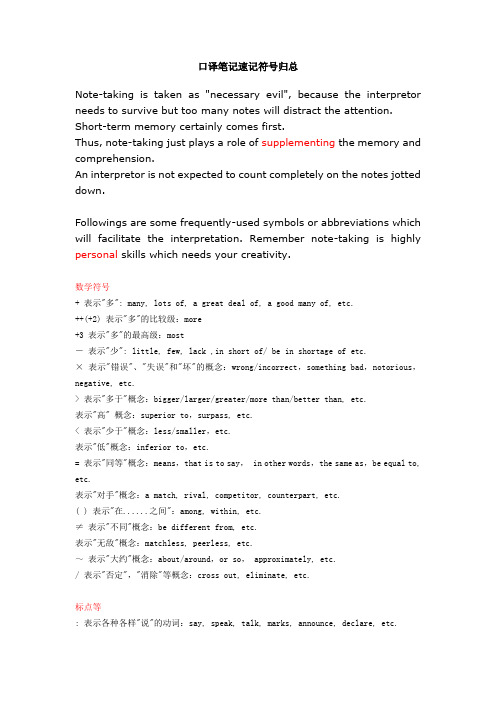
口译笔记速记符号归总Note-taking is taken as "necessary evil", because the interpretor needs to survive but too many notes will distract the attention. Short-term memory certainly comes first.Thus, note-taking just plays a role of supplementing the memory and comprehension.An interpretor is not expected to count completely on the notes jotted down.Followings are some frequently-used symbols or abbreviations which will facilitate the interpretation. Remember note-taking is highly personal skills which needs your creativity.数学符号+ 表示"多": many, lots of, a great deal of, a good many of, etc.++(+2) 表示"多"的比较级:more+3 表示"多"的最高级:most-表示"少": little, few, lack ,in short of/ be in shortage of etc.× 表示"错误"、"失误"和"坏"的概念:wrong/incorrect,something bad,notorious,negative, etc.> 表示"多于"概念:bigger/larger/greater/more than/better than, etc.表示"高" 概念:superior to,surpass, etc.< 表示"少于"概念:less/smaller,etc.表示"低"概念:inferior to,etc.= 表示"同等"概念:means,that is to say, in other words,the same as,be equal to, etc.表示"对手"概念:a match, rival, competitor, counterpart, etc.( ) 表示"在......之间":among, within, etc.≠ 表示"不同"概念:be different from, etc.表示"无敌"概念:matchless, peerless, etc.~表示"大约"概念:about/around,or so, approximately, etc./ 表示"否定","消除"等概念:cross out, eliminate, etc.标点等: 表示各种各样"说"的动词:say, speak, talk, marks, announce, declare, etc.? 表示"问题":question,issue,例如:台湾问题:tw?. (dot) 这个"."点的位置不同表示的概念也不一样".d"表示yesterday, ".y"表示last year, ".2m"表示two month ago。
口译笔记速记符号归总

有趣的口译笔记符号第一轮的口译学习接近尾声了,很庆幸没有再一次错过。
想起它便多了一丝安慰,也明白心里面还有一些东西没有实现。
大学的时我就想系统学习口译, 却因为各种“原因”错过。
而工作以后再也不可能连请40天假去北京学习。
现在终于有机会在一家本地的翻译协会学习,虽然老师水平很一般,不过教我错错有余。
除了发现自己的基本功还很不够,也有了一点小小的感悟,渐渐明白为什么说口译是一门熟能生巧的技术活,也是一门艺术。
口译的过程可以概述为接受- 解码-记录-编码-表达。
其中,前四个步骤是由译员单独完成的,最后一项是由直接与听众沟通完成的。
记录的部分就是笔记,笔记是由符号组成的。
翻译时先把听到的语言转换成符号记录下来,再把符号转换成另一种语言。
虽然语言不同,符号却相同。
终于理解为什么前辈们说翻译是翻意思不翻词。
文字只是一种表达形式,而活跃在文字之上的是意思,是思想。
符号可以介于文字和思想之间。
也许在文字还没有被创造之前符号就被创造出来了。
小说《达.芬奇密码》中的宗教符号学教授罗拨.兰顿就利用符号发现了秘密。
虽然小说是虚构的,不过现实生活中简单的符号可以留给人们无尽的想象空间。
下面分享一些口译中的简单符号:数学符号:+ 表示"多",“另外”: many, lots of, a great deal of, a good many of, etc.++(+2) 表示"多"的比较级:more, , plus, add, moreover, besides,etc.+3 表示"多"的最高级:most-表示"少", “减去,除去,除了”: little, few, lack ,in short of/ be in shortage of ,minus, deduct, except, etc.×表示"错误"、"失误"和" 不好的,负面的"的概念:wrong/incorrect,mistake,notorious,negative, etc.> 表示"多于"概念:bigger/larger/greater/more than/better than, etc.表示"高" 概念:superior to,surpass, etc< 表示"少于"概念:less than /smaller,etc.表示"低"概念:inferior to,etc.= 表示"同等,一致,公平"概念:means,that is to say,in other words,the same as,be equal to, etc.表示"对手"概念:a match, rival, competitor, counterpart, etc.( ) 表示"在......之中,在……之内":among, within, etc.≠表示"不同,不公平,有差距"概念:be different from, disparity,etc.表示"无敌"概念:matchless, peerless, etc.~表示"大约"概念:about/around,almost, nearly, or so,approximately, etc./ 表示"否定","消除"等概念:cross out, eliminate, etc.标点符号:: 表示各种各样"说"的动词:say, speak, talk, marks, announce, declare, etc.? 表示"问题":question,issue,例如:台湾问题:tw?. (dot) 这个"."点的位置不同表示的概念也不一样".d"表示yesterday, ".y"表示last year, ".2m"表示two month ago。
口译笔记符号大汇总(超全整理版_方便直接背诵)
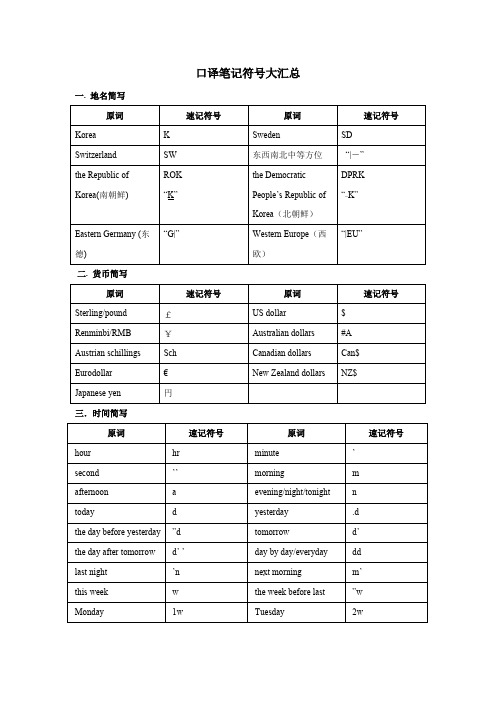
口译笔记符号大汇总一. 地名简写原词速记符号原词速记符号Korea K Sweden SD Switzerland SW东西南北中等方位“|-”the Republic of Korea(南朝鲜)ROK“K”the DemocraticPeople’s Republic ofKorea(北朝鲜)DPRK“_K”Eastern Germany (东德)“G|”Western Europe(西欧)“|EU”二. 货币简写原词速记符号原词速记符号Sterling/pound£US dollar$Renminbi/RMB¥Australian dollars#AAustrian schillings Sch Canadian dollars Can$ Eurodollar€New Zealand dollars NZ$ Japanese yen円三.时间简写原词速记符号原词速记符号hour hr minute’second’’morning m afternoon a evening/night/tonight ntoday d yesterday.dthe day before yesterday”d tomorrow d’the day after tomorrow d’ ’day by day/everyday ddlast night’n next morning m’this week w the week before last”wMonday1w Tuesday2wWednesday3w Thursday4wFriday5w Saturday6wSunday7w this month mJanuary1m February2mMarch3m April4mMay5m June6mJuly7m August8m September9m October10m November11m December12dmtwo month ago.2m this year ytwo year later y2.1949年前/491949年后49/1949年底4920年以后20y|century Csince/ever since┠uo to now/ until┫四.度量衡原词速记符号原词速记符号meter m inch in. centimeter cm foot ftminimeter mm knot ktmile mi acre Anautical mile nm五. 缩略词原词速记符号原词速记符号Apartment APT Accountant ACC According ACDG Accept ACPT Advertisement AD Address ADS aircraft AC at least ALAdvice ADV Approve APVas soon as possible ASAP As much/many as possible AMAPare R Amount AMT Building BLDG Balance BAL Cancel CNCL Conference CNF carbon copy cc care of c/o Conform CFM Commission CMI Complete CMP Concern/concerning/concerned CONC Condition COND Communication CMU Compete/competitive CMPE Certificate CERT Company CO.Departure DPT Discount DISC Department DEPT Extent EXT Exchange EXCH Explain EXPLN Extra large XL Final FNT Flight FLT For your reference FYR Freight FRT Guarantee GUAR Good GD Home office H.O.Interested INTST Information INFO important IMPI owe you IOU In stead of I/OIn view of IVO Include IINCD insurance INS Impossible IMPS Individual INDIV Minimum MIN Market MKT Manufacture MANUF Message MSG manager MGR Model MDL Memorandum MEMO No later than NLT Necessary NCRY Ordinary ORD Observe OBS Obtain OBT Product PROD Patent PAT Packing PKG Please PLS People PLPiece PC Position POSNPossible POSS(BL)Quantity QUTYQuality QLTY room RMRegular REGL Representative REPReservation RESN Repeat RPTResponsible RESPON receive RCVReference REF Situation SITNStandard STD Section SECThough THO TGM TelegraphThanks TKS Telephone TELTrade TRD through THRUTemporary TEMP Traffic TRFTotal TTL You UYour UR Will WLWeek WK Weight WT六.较长单词的处理办法词尾缩写原词速记符号-ism m socialism Sm-tion n standardization (标准化)stdn-cian o technician techo-ing g marketing (市场营销)MKTg-ed d accepted acptd-able/ible/ble bl available avbl-ment mt amendment amdmt-ize z recognize regz-ful fl meaningful mnfl七.字母、图像、符号原词速记符号原词速记符号people/person人o右上角Janpanese日本人JPoGovernment/govern C 政府Governmental official CZPolitics/political P 政治politician PZEfficient/effective G 效率inflation Q 通货膨胀victory,/win/success V 胜利Leader/head T 领导人agriculture/agriculture A 农业business B 商业conflict/confrontation C× 冲突/矛盾work/employ W 工作/职业industry/industrial i 工业treaty/agreement U 合同/协议bilateral(双边的)U内填入2trilateral (三边的)U内填入3 Unilateralism(单边主义)U内填入1Multiple(多边主义)U内填入m谈判破裂U上加一个“/”country/state/nation□国家/民族/领土Import进口gO outport出口Ogchair/ host/preside over Z主持/主办Chairman/host Z°主席、主持人contact, exchanges:∞联系fishery∞捕鱼业head of government/ company CTinternational/worldwide/global/universal ○国际的/世界的/全球的as we all know/ as is known to all/as you have already heard of EO 听到/众所周之meeting/conference/negotiation/seminar/discussion/symposium⊙会议/开会pleasant/joyful/happy/excitedJ 开心/高兴/荣幸/好现象unsatisfied/discomfort/angry/sadL 生气/难过/悲伤/忧虑/不满indifferent/apathetic/unconcern/ don’t care much O 漠不关心/无动于衷total/totally/entire/entirely/onthe whole/all in all/to sum up∑总值/总数go into/arrive at/give to/sendto/present to g→到达/传达lead to/result in/in thedirection of→导致/引导come/go back to/originate←追溯到be/come from/return/receivefromf←自于launch/open/start↗发射/投放市场/发行develop/strengthen/promote/boost,/improve/enhance↑发展/加强/推进up/upward/rise/increase/h↑上升ups and downs/twists and << 波折arise/ascend turns/roller coastersubmit to↓屈服exchange/mutual n交流a match /rival /competitor/counterpart/against VS对手many/lots of/a great deal of/agood many of/plus+ 多/加之/加上/补充more++/+2多的比较级most+3 多的最高级little/few/lack/in short of/be inshortage of/minus -少/减去/除去about/around/orso/approximately≈大约bigger/larger/greater/more than/better than > 大于/多于/好于/优于less/smaller< 小于/少于/差于/劣于superior to/surpass∧高inferior to∨低among/within( ) 在...之间but yet however∧转折cross out/eliminate/ 否定/消除question/issue? 问题/疑惑/难题wonder/miracle/pay attesion to!惊叹/特别注意matchless/peerless无敌say/speak/talk/marks/announce/declare : 说/认为/希望end/stop/halt/bring sth to astandstill/stop∥结束right/good/famous/well-known√对/正确/好的wrong/incorrect/somethingbad/notorious/negative× 错误/失误/坏stand up for/support/ agree withsb/certain/ affirmativeY同意not agree/disagree N不同意thought*想法/重要的/优秀的important/best/outstanding/brilliant☆重要的very/extremely__ 强调程度under the circumstance ̄在…的条件/情况下means/that is to say/in otherwords/the same as/be equal to =即/等于/相当于/同等be different from≠不同/不等于/不相当/不是and/together with/along &和/与belong to∈属于with/accompany/alongwith/further morebasis of/ perpendicular/ isperpendicular to ⊥ …的基础therefore/so/as a result/consequently∴所以/结果because/because of/due to∵因为/由于/多亏hear/listen○3听说about@关于parallel// water H2O for4to2without w/o with w/plus or minus±times x so on, etc, and so forth ···divided by÷circle, circumference○degree℃ellipse0 percent%diameterθper thousand‰triangle, delta △between|.|inside/ within/include/ among,( ) maintaining peace and stability: ◎Empty Oas always/hold on,/persist/ insist on ≡一直/总是/一贯pressure/influence⊥(竖线为向下箭头)On the other hand/or/ 或者right angle∟Representative/delegation/ delegation △ocean/sea/river/lake/brook/stream∽江河湖海水hills/mountainω山climb the mountainω上加一点·山水之间ω∕∽before/beyond/in front of·|above/on/over~上加一点·below/beneath/under~下加一点·table/desk/house/building/bed︹桌/凳/床/楼/房在椅子上︹上加一短横在桌子下︹下加一短横look/ look after/ look into/investigate/witness⊙资本主义资’四个现代化4mpeace-keeping维p第三世界3w。
(2021年整理)口译笔记速记符号归总---笔记符号汇总

口译笔记速记符号归总---笔记符号汇总编辑整理:尊敬的读者朋友们:这里是精品文档编辑中心,本文档内容是由我和我的同事精心编辑整理后发布的,发布之前我们对文中内容进行仔细校对,但是难免会有疏漏的地方,但是任然希望(口译笔记速记符号归总---笔记符号汇总)的内容能够给您的工作和学习带来便利。
同时也真诚的希望收到您的建议和反馈,这将是我们进步的源泉,前进的动力。
本文可编辑可修改,如果觉得对您有帮助请收藏以便随时查阅,最后祝您生活愉快业绩进步,以下为口译笔记速记符号归总---笔记符号汇总的全部内容。
口译笔记速记符号归总目录[1]。
Note-taking symbols and abbreviations[2]。
关于缩略词[3].关于字母和图像[4]。
用箭头、数字符号、标点符号来表示1。
Note—taking symbols and abbreviations for your reference: Abbreviations in Note takingUse only the abbreviations that fit your needs and that you will remember easily. A good idea is to introduce only a few abbreviations into your note taking at a time。
Symbols helpful in math —— these are commonly used in texts and references。
S = sumf = frequencyLeave out periods in standard abbreviations.cf = comparee.g。
= exampledept = departmentUse only the first syllable of a word。
(完整版)口译笔记符号大汇总(超全整理版_方便直接背诵)
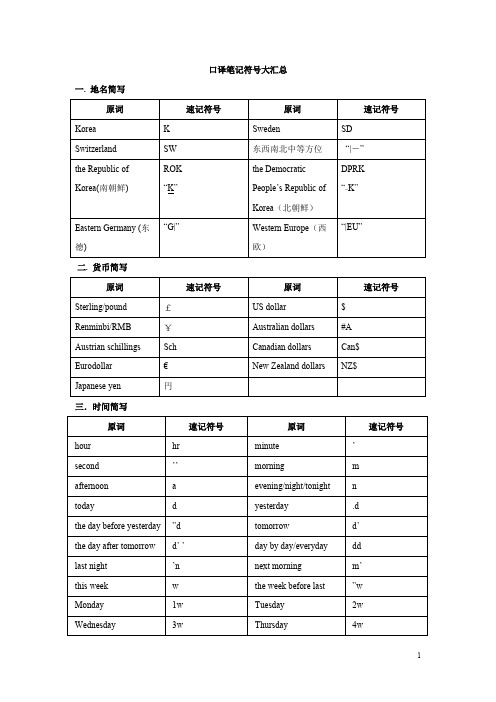
口译笔记符号大汇总一. 地名简写原词速记符号原词速记符号Korea K Sweden SD Switzerland SW东西南北中等方位“|-”the Republic of Korea(南朝鲜)ROK“K”the DemocraticPeople’s Republic ofKorea(北朝鲜)DPRK“_K”Eastern Germany (东德)“G|”Western Europe(西欧)“|EU”二. 货币简写原词速记符号原词速记符号Sterling/pound£US dollar$Renminbi/RMB¥Australian dollars#AAustrian schillings Sch Canadian dollars Can$ Eurodollar€New Zealand dollars NZ$ Japanese yen円三.时间简写原词速记符号原词速记符号hour hr minute’second’’morning m afternoon a evening/night/tonight ntoday d yesterday.dthe day before yesterday”d tomorrow d’the day after tomorrow d’ ’day by day/everyday ddlast night’n next morning m’this week w the week before last”wMonday1w Tuesday2w Wednesday3w Thursday4wFriday5w Saturday6wSunday7w this month mJanuary1m February2mMarch3m April4mMay5m June6mJuly7m August8m September9m October10m November11m December12dmtwo month ago.2m this year ytwo year later y2.1949年前/491949年后49/1949年底4920年以后20y|century Csince/ever since┠uo to now/ until┫四.度量衡原词速记符号原词速记符号meter m inch in. centimeter cm foot ftminimeter mm knot ktmile mi acre Anautical mile nm五. 缩略词原词速记符号原词速记符号Apartment APT Accountant ACC According ACDG Accept ACPT Advertisement AD Address ADS aircraft AC at least ALAdvice ADV Approve APVas soon as possible ASAP As much/many as possible AMAPare R Amount AMTBuilding BLDG Balance BAL Cancel CNCL Conference CNF carbon copy cc care of c/o Conform CFM Commission CMI Complete CMP Concern/concerning/concerned CONC Condition COND Communication CMU Compete/competitive CMPE Certificate CERT Company CO.Departure DPT Discount DISC Department DEPT Extent EXT Exchange EXCH Explain EXPLN Extra large XL Final FNT Flight FLT For your reference FYR Freight FRT Guarantee GUAR Good GD Home office H.O.Interested INTST Information INFO important IMPI owe you IOU In stead of I/OIn view of IVO Include IINCD insurance INS Impossible IMPS Individual INDIV Minimum MIN Market MKT Manufacture MANUF Message MSG manager MGR Model MDL Memorandum MEMO No later than NLT Necessary NCRY Ordinary ORD Observe OBS Obtain OBT Product PROD Patent PAT Packing PKG Please PLS People PL Piece PC Position POSNPossible POSS(BL)Quantity QUTYQuality QLTY room RMRegular REGL Representative REPReservation RESN Repeat RPTResponsible RESPON receive RCVReference REF Situation SITNStandard STD Section SECThough THO TGM TelegraphThanks TKS Telephone TELTrade TRD through THRUTemporary TEMP Traffic TRFTotal TTL You UYour UR Will WLWeek WK Weight WT六.较长单词的处理办法词尾缩写原词速记符号-ism m socialism Sm-tion n standardization (标准化)stdn-cian o technician techo-ing g marketing (市场营销)MKTg-ed d accepted acptd-able/ible/ble bl available avbl-ment mt amendment amdmt-ize z recognize regz-ful fl meaningful mnfl七.字母、图像、符号原词速记符号原词速记符号people/person人o右上角Janpanese日本人JPoGovernment/govern C 政府Governmental official CZPolitics/political P 政治politician PZEfficient/effective G 效率inflation Q 通货膨胀victory,/win/success V 胜利Leader/head T 领导人agriculture/agriculture A 农业business B 商业conflict/confrontation C× 冲突/矛盾work/employ W 工作/职业industry/industrial i 工业treaty/agreement U 合同/协议bilateral(双边的)U内填入2trilateral (三边的)U内填入3 Unilateralism(单边主义)U内填入1Multiple(多边主义)U内填入m谈判破裂U上加一个“/”country/state/nation□国家/民族/领土Import进口gO outport出口Ogchair/ host/preside over Z主持/主办Chairman/host Z°主席、主持人contact, exchanges:∞联系fishery∞捕鱼业head of government/ company CTinternational/worldwide/global/universal ○国际的/世界的/全球的as we all know/ as is known to all/as you have already heard of EO 听到/众所周之meeting/conference/negotiation/seminar/discussion/symposium⊙会议/开会pleasant/joyful/happy/excitedJ 开心/高兴/荣幸/好现象unsatisfied/discomfort/angry/sadL 生气/难过/悲伤/忧虑/不满indifferent/apathetic/unconcern/ don’t care much O 漠不关心/无动于衷total/totally/entire/entirely/onthe whole/all in all/to sum up∑总值/总数go into/arrive at/give to/sendto/present to g→到达/传达lead to/result in/in thedirection of→导致/引导come/go back to/originate←追溯到be/come from/return/receivefromf←自于launch/open/start↗发射/投放市场/发行develop/strengthen/promote/boost,/improve/enhance↑发展/加强/推进up/upward/rise/increase/arise/ascend h↑上升ups and downs/twists andturns/roller coaster<< 波折submit to↓屈服exchange/mutual n交流a match /rival /competitor/counterpart/against VS对手many/lots of/a great deal of/agood many of/plus+ 多/加之/加上/补充more++/+2多的比较级most+3 多的最高级little/few/lack/in short of/be inshortage of/minus -少/减去/除去about/around/orso/approximately≈大约bigger/larger/greater/more than/better than > 大于/多于/好于/优于less/smaller< 小于/少于/差于/劣于superior to/surpass∧高inferior to∨低among/within( ) 在...之间but yet however∧转折cross out/eliminate/ 否定/消除question/issue? 问题/疑惑/难题wonder/miracle/pay attesion to!惊叹/特别注意matchless/peerless无敌say/speak/talk/marks/announce/declare : 说/认为/希望end/stop/halt/bring sth to astandstill/stop∥结束right/good/famous/well-known√对/正确/好的wrong/incorrect/somethingbad/notorious/negative× 错误/失误/坏stand up for/support/ agree withsb/certain/ affirmativeY同意not agree/disagree N不同意thought*想法/重要的/优秀的important/best/outstanding/brilliant☆重要的very/extremely__ 强调程度under the circumstance ̄在…的条件/情况下means/that is to say/in otherwords/the same as/be equal to =即/等于/相当于/同等be different from≠不同/不等于/不相当/不是and/together with/alongwith/accompany/along&和/与belong to∈属于with/further morebasis of/ perpendicular/ isperpendicular to ⊥ …的基础therefore/so/as a result/consequently∴所以/结果because/because of/due to∵因为/由于/多亏hear/listen○3听说about@关于parallel// water H2O for4to2without w/o with w/plus or minus±times x so on, etc, and so forth ···divided by÷circle, circumference○degree℃ellipse0 percent%diameterθper thousand‰triangle, delta △between|.|inside/ within/include/ among,( ) maintaining peace and stability: ◎Empty Oas always/hold on,/persist/ insist on ≡一直/总是/一贯pressure/influence⊥(竖线为向下箭头)On the other hand/or/ 或者right angle∟Representative/delegation/ delegation △ocean/sea/river/lake/brook/stream∽江河湖海水hills/mountainω山climb the mountainω上加一点·山水之间ω∕∽before/beyond/in front of·|above/on/over~上加一点·below/beneath/under~下加一点·table/desk/house/building/bed︹桌/凳/床/楼/房在椅子上︹上加一短横在桌子下︹下加一短横look/ look after/ look into/investigate/witness⊙资本主义资’四个现代化4mpeace-keeping维p第三世界3w二、字母、图像Z 表示"人"people/person,因为"Z"看上去像个人头,它通常被写在一个词或符号的右上角。
口译常用的笔记符号汇总

口译常用的笔记符号汇总一、前言口译笔记是一种有效的辅助工具,能够帮助译员记录关键信息,提高翻译的准确性和效率。
正确的笔记可以帮助译员在紧张的口译环境中保持清晰思维,避免因遗忘或疏忽而造成的错误。
本篇文档旨在汇总口译过程中常用的笔记符号,以便译员在实践中参考和使用。
二、笔记符号说明1.缩写词:用字母、数字等简洁形式记录单词或短语,如“u”代表“under”,“m”代表“meeting”。
2.符号:用各种符号记录概念、观点、人名等,如“△”代表“注意”,“☆”代表“重要”。
3.符号组合:将多个符号组合使用,表达更复杂的含义,如“⊙”+“b”+“√”代表“乙方已确认”。
4.线条:用线条记录时间和空间信息,如“↑”代表时间推进,“●”代表地点。
5.特殊符号:用特殊符号记录特殊概念或情况,如“*”代表突发情况,“#”代表需要特别关注的人或事。
6.标注:在单词、短语或句子旁边添加注释,如“注意语法”、“需要核实信息”。
三、笔记符号分类1.词汇类:包括名词、动词、形容词、副词等基本词汇的记录,如“公司”、“讨论”、“热情”、“快速”。
2.句式类:包括常用句型、表达方式、习惯用语的记录,如“如果…就…”,“预期效果是…”。
3.人名地名类:包括人名、地名等专有名词的记录,如“张三”、“北京”、“上海”。
4.特殊符号类:包括数字、货币、度量衡等特殊概念的记录,如“100元”,“50公斤”。
5.时间空间类:包括时间、日期、星期、月份、季节、天气等空间信息的记录,如“今天星期四”,“会议在会议室进行”。
四、常见笔记符号示例1.缩写词示例:“d=day,n=night,e=email”2.符号示例:“▲=减慢速度,●=暂停”,“※=重要信息”,“$=货币符号”,“※+手+√=手记确认”3.符号组合示例:“※+笔+√=需要记录的信息”,“●+椅子+√=休息地点”4.标注示例:“√=已同意”,“?=需要进一步确认”,“↑=增加音量”,“↓=降低音量”5.时间空间示例:“↑9:00”,“↓会议室”,“#主席台”五、总结口译过程中,正确的笔记可以帮助译员快速记录关键信息,提高翻译效率。
整理版 口译符号
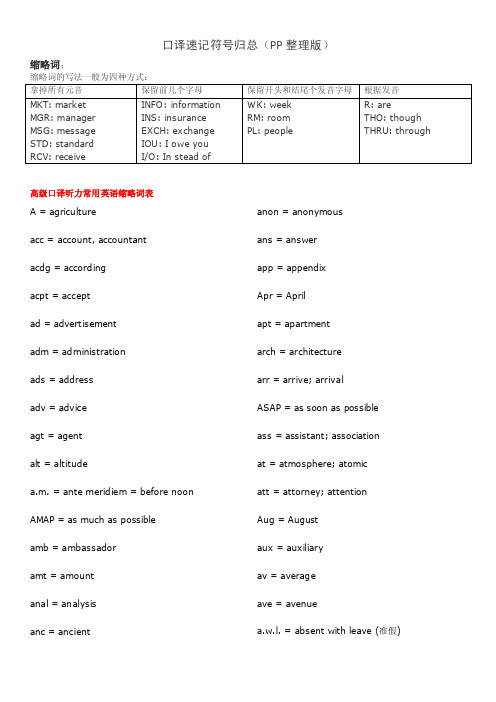
dep = deposit DEPT = department disc = discount dist = distance; distinguish div = divide; divorced do. = ditto (同上) dorm = dormitory dpt = departure dz = dozen e = east; earth; engineering econ = economics; economy ed. = education; editor e.g. = exempli gratia = for example encl. = enclosed; enclosure esp. = especially etc. = et cetera = and so on ex. = example; exception; extra exp. = export expln = explain ext = extend; extension FAX = facsimile Feb. = February
i.a. = in absence; absent km = kilometer (公里) ib. = ibidem = in the same place ID = identity; identity card i.e. = id est = that is L/C = letter of credit (信用证) imp = import; imperial IMPS = impossible IMPT = important in. = inch; inches ind = industrial; independent indiv = individual info = information ins = insurance inst. = instant; institute int. = interior; interest (兴趣;利息) leg = legal lib = library; librarian liq = liquid lit = literature long. = longitude M.A. = Master of Arts mach = machinery mag = magazine man. = manual; manufacture lat. = lat itude lb. = pounds (磅;英镑)
口译笔记速记符号归总(二)

口译笔记速记符号归总(二)一、缩略词英语当中缩略词使用的频率很高,如IMP: important, ASAP: as soon as possible.很显然如果能熟练掌握缩略词,会对考试大有裨益。
缩略词的写法一般为四种方式:F拿掉所有元音MKT: marketMGR: managerMSG: messageSTD: standardRCV: receiveF保留前几个字母INFO informationINS insuranceEXCH exchangeI owe you IOUIn stead of I/OF保留开头和结尾个发音字母WK weekRM roomPL peopleF根据发音R areTHO thoughTHRU through高级口译听力常用英语缩略词表缩略词原词APT ApartmentACC AccountantACDG AccordingACPT AcceptAD AdvertisementADS AddressADV AdviceAMAP As much/many as possibleAMT AmountAPV ApproveASAP As soon as possibleBAL BalanceBLDG BuildingCERT CertificateCFM ConformCNCL CancelCNF ConferenceCMI CommissionCMP CompleteCMPE Compete/competitiveCMU CommunicationCONC Concern/concerning/concerned COND ConditionCO. CompanyDEPT DepartmentDISC DiscountDPT DepartureEXCH ExchangeEXPLN ExplainEXT ExtentFLT FlightFNT FinalFRT FreightFYR For your referenceGD GoodGUAR GuaranteeH.O. Home officeINFO InformationIMPS ImpossibleIMP(T) ImportantINCD IncludeINDIV IndividualINS InsuranceINTST InterestedI/O In stead of IOU I owe youIVO In view of MANUF Manufacture MDL ModelMEMO Memorandum MGR MangerMIN MinimumMKT MarketMSG MessageNCRY NecessaryNLT No later than OBS ObserveOBT ObtainORD OrdinaryPAT PatentPC PiecePKG PackingPL PeoplePLS PleasePOSN Position POSS(BL) Possible PROD ProductQLTY QualityQUTY QuantityRCV ReceiveREF Reference REGL RegularREP Representative RESN Reservation RPT Repeat RESPON Responsible SEC SectionSITN SituationSTD StandardTEL TelephoneTEMP TemporaryTGM TelegraphTHO ThoughTKS ThanksTRD TradeTRF TrafficTTL TotalU YouUR YourWK WeekWL WillWT WeightXL Extra large补充口译笔记符号口译笔记中的符号是为了满足口译时间紧迫性要求而采用的。
口译笔记速记符号归总(二)

口译笔记速记符号归总(二)一、缩略词英语当中缩略词使用的频率很高,如IMP: important, ASAP: as soon as possible.很显然如果能熟练掌握缩略词,会对考试大有裨益。
缩略词的写法一般为四种方式:F拿掉所有元音MKT: marketMGR: managerMSG: messageSTD: standardRCV: receiveF保留前几个字母INFO informationINS insuranceEXCH exchangeI owe you IOUIn stead of I/OF保留开头和结尾个发音字母WK weekRM roomPL peopleF根据发音R areTHO thoughTHRU through高级口译听力常用英语缩略词表缩略词原词APT ApartmentACC AccountantACDG AccordingACPT AcceptAD AdvertisementADS Address真的不掉线吗??、????????????ADV AdviceAMAP As much/many as possibleAMT AmountAPV ApproveASAP As soon as possibleBAL BalanceBLDG BuildingCERT CertificateCFM ConformCNCL CancelCNF ConferenceCMI missionCMP pleteCMPE pete/petitiveCMU municationCONC Concern/concerning/concerned COND ConditionCO. panyDEPT DepartmentDISC DiscountDPT DepartureEXCH ExchangeEXPLN ExplainEXT ExtentFLT FlightFNT FinalFRT FreightFYR For your referenceGD GoodGUAR GuaranteeH.O. Home officeINFO InformationIMPS ImpossibleIMP(T) ImportantINCD IncludeINDIV IndividualINS InsuranceINTST InterestedI/O In stead ofIOU I owe you真的不掉线吗??、????????????IVO In view ofMANUF ManufactureMDL ModelMEMO MemorandumMGR MangerMIN MinimumMKT MarketMSG MessageNCRY NecessaryNLT No later than OBS ObserveOBT ObtainORD OrdinaryPAT PatentPC PiecePKG PackingPL PeoplePLS PleasePOSN Position POSS(BL) Possible PROD ProductQLTY QualityQUTY QuantityRCV ReceiveREF Reference REGL RegularREP Representative RESN Reservation RPT Repeat RESPON ResponsibleSEC SectionSITN SituationSTD StandardTEL TelephoneTEMP TemporaryTGM TelegraphTHO ThoughTKS ThanksTRD TradeTRF TrafficTTL TotalU You真的不掉线吗??、????????????UR YourWK WeekWL WillWT WeightXL Extra large 真的不掉线吗??、????????????小学毕业考试试卷(以下分数不能正常显示但可正常打印)一、计算(23分)1.直接写出得数(5分)0.22= 6.8+1.28= 0.5÷0.25=50×30%= 1-1÷7=6÷=56×24= 2008-199=+= 2.5×0.7×0.4=2.下面各题怎样算简便就怎样算(12分)3.解方程(6分)×16-2÷1213×(52-13) 1-x=[6.85-(0.65+0.7)]÷2.5 (+)×7+=二、操作(12分)1.下面每个小正方形的边长表示1厘米,请按要求画图。
- 1、下载文档前请自行甄别文档内容的完整性,平台不提供额外的编辑、内容补充、找答案等附加服务。
- 2、"仅部分预览"的文档,不可在线预览部分如存在完整性等问题,可反馈申请退款(可完整预览的文档不适用该条件!)。
- 3、如文档侵犯您的权益,请联系客服反馈,我们会尽快为您处理(人工客服工作时间:9:00-18:30)。
口译笔记速记符号归总一、做口译笔记时的注意事项1.口译笔记应记要点,切忌求记“全”。
口译笔记是记忆的延伸或补充,不应也不必取代记忆。
口译笔记的主要内容是概念、命题、名称、数字、组织机构和逻辑关系(如大小、先后、正反、上下、升降、因果关系等),笔记单位以表达意群的词语和符号为主。
2.口译笔记求快求精,但不可潦草。
3.口译笔记可使用来源语,也可使用目标语,也可以双语兼用。
只要有利于口译的准确性和流利性,不必拘泥于某种文字或符号。
例如,“联合国大会”可笔录为“UN”或“联大”。
4.口译笔记使用大量常见略语,例如:cf(compare), Co(company), eg(for example), etc(and so on), esp(especially), ie(that is), max(maximum),min(minimum), ref(reference), std(standard), usu(usually),等。
二、常用速记符号速记是一项特殊的技巧,速记语言是由一套完整的符号组成的体系。
在口译实践中逐步掌握一些简单的速记符号是有益的。
口译成功与否在很大程度上取决于译员在口译表达前对感知的信息进行记录的能力。
记录分为“脑记”和“笔记”两种。
人脑的记忆由短时记忆和长时记忆两部分组成。
顾名思义,短时记忆是一种操作性的暂时记忆,长时记忆属于一种储存性的永久记忆。
影响一个人短时记忆的因素很多,其中最主要的因素是记忆内容的意义性。
即便是当感知的信息有意义时,人的短时记忆只可容纳由二十多个单词组成的句子,或者一组十位数的数字。
因此,对于口译工作者来说,完全依赖人脑的记忆能力是危险的,记笔记便显得十分重要。
in Note takingUse only the abbreviations that fit your needs and that you will remember easily. A good idea is to introduce only a few abbreviations into your note taking at a time.Symbols helpful in math -- these are commonly used in texts and references. S=sumf=frequencyLeave out periods in standard abbreviations.cf=comparee.g.=exampledept=departmentUse only the first syllable of a word.pol=politicsdem=democracylib=liberalcap=capitalismUse entire first syllable and only 1st letter of 2nd syllable.pres=presentationsubj=subjectind=individualcons=conservativeEliminate final letters. Use just enough of the word to form a recognizable abbreviation.assoc=associatebiol=biologyinfo=informationach=achievementchem=chemistrymax=maximumintro=introductionconc=concentrationmin=minimumrep=repetitionOmit vowels, retain only enough consonants to give a recognizable skeleton of the word.ppd=preparedprblm=problemestmt=estimatebkgd=backgroundgvt=governmentUse an apostrophe in place of letters.am't=amountcont'd=continuedgov't=governmenteducat'l=educationalForm the plural of a symbol or abbreviated word by adding s.chpts=chaptersegs=examplesfs=frequenciesintros=introductionsUse g to represent ing endings.ckg=checkingestg=establishingdecrg=decreasingexptg=experimentingSpell out short words such as in, at, to, but, for, and key.Abbreviations or symbols for short words will make the notes too dense with shorthand.Leave out unimportant words.Leave out the words a and the.If a term, phrase, or name is written out in full during the lecture, substitute initials whenever the term, phrase, or name is used again. For example, Center for Aerospace Sciences becomes CAS thereafter.Use symbols for commonly recurring connective or transitional words. &=andw/=withw/o=withoutvs=against\=therefore==is or equalUse technical symbols where applicable.zb=German, for exampleibid=Latin, the same worko=degreesH2O=waterMore reference:Use standard maths, accounting, and science symbols. Examples:+ plus// parallelUse standard abbreviations and leave out full stops. Examples:eg exampleIT dept Information Technology departmentUK United KingdomUse only the first syllable of a word. Examples:mar marketingcus customercli clientUse the entire first syllable and the first letter of the second syllable. Examples:subj subjectbudg budgetind individualTo distinguish among various forms of the same word, use the first syllable of the word, an apostrophe, and the ending of the word. Examples: tech'gy technologygen'ion generalisationdel'y deliveryUse just enough of the beginning of a word to form a recognisable abbreviation. Examples:assoc associatedach achievementinfo informationOmit vowels from the middle of words, retaining only enough consonants to provide a recognisable skeleton of the word. Examples:bkgd backgroundmvmt movementprblm problemForm the plural of a symbol or abbreviated word by adding 's.' Examples: custs customersfs frequencies/s ratiosUse 'g' to represent 'ing' endings. Examples:decrg decreasingckg checkingestblg establishingSpell out, rather than abbreviate short words. Examples:inbutaskeyLeave out unimportant verbs. Examples:iswaswereLeave out unnecessary articles. Examples:aantheIf a term, phrase, or name is initially written out in full during thetalk or meeting, initials can be substituted whenever the term, phrase, or name is used again. Example:January Advertising Campaign Budget JACBUse symbols for common connective or transition words. Examples:@ at2 to4 for& andw/ withw/o withoutvs againstCreate your own set of abbreviations and symbols. You may wish to develop separate sets of symbols and abbreviations for different courses or subjects.Other Symbols and Abbreviationsas a result of / consequences of <--->resulting in --->and / also +equal to / same as =following ffmost importantly *less than <greater than > especially esp/一、缩略词英语当中缩略词使用的频率很高,如IMP: important, ASAP: as soon as possible。
